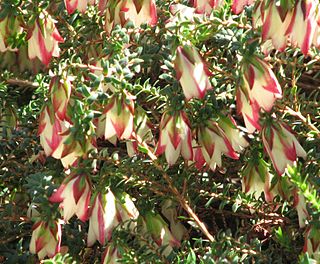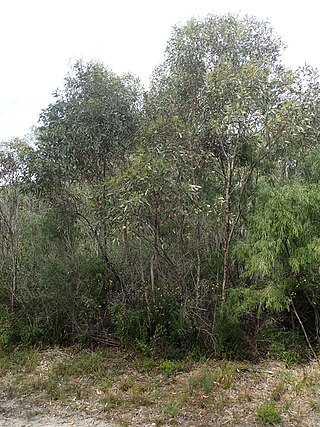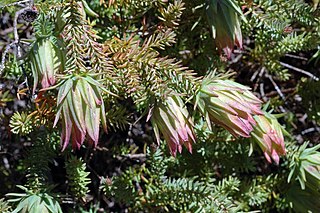
Darwinia macrostegia, commonly known as Mondurup bell, is a species of flowering plant in the family Myrtaceae and is endemic to the south-west of Western Australia. It is a straggly shrub with elliptic leaves and clusters of pendent flowers surrounded by red and white bracts.

Beaufortia cyrtodonta, commonly known as Stirling Range bottlebrush, is a plant in the myrtle family, Myrtaceae and is endemic to the southwest of Western Australia. It is a compact shrub with crowded leaves which appear greyish due to their covering of fine, soft hairs. It has heads of red flowers in spring and occurs in the Stirling Range district.

Eucalyptus falcata, commonly known as silver mallet or toolyumuck, is a species of mallee or marlock that is endemic to Western Australia. It has smooth bark, lance-shaped to curved adult leaves, flower buds in groups of eleven or thirteen, creamy white or yellowish green flowers and flattened spherical fruit.

Eucalyptus goniantha, commonly known as Jerdacuttup mallee, is a species of mallee, or rarely a tree, that is endemic to Western Australia. It has smooth bark, lance-shaped adult leaves, flower buds in groups of between seven and eleven, creamy white flowers and more or less ribbed, hemispherical fruit.

Eucalyptus uncinata, commonly known as the hook-leaved mallee, is a species of mallee that is endemic to the southwest of Western Australia. It has smooth bark, lance-shaped adult leaves, flower buds arranged in groups of nine to thirteen, creamy white flowers and barrel-shaped to oval or cylindrical fruit.

Eucalyptus xanthonema, commonly known as yellow-flowered mallee, is a species of mallee that is endemic to the south west of Western Australia. It has smooth bark, linear adult leaves, flower buds in groups of up to eleven, white to pale lemon-coloured flowers and barrel-shaped fruit.

Platysace commutata is a shrub that is endemic to the south-west of Western Australia. It has linear leaves and white to cream-coloured or blue flowers.

Darwinia oederoides is a species of flowering plant in the family Myrtaceae and is endemic to the south-west of Western Australia. It is a low, spreading shrub with linear leaves and clusters of pendent flowers surrounded by red and yellow bracts.

Thryptomene racemulosa is a species of flowering plant in the family Myrtaceae and is endemic to Western Australia. It is a shrub that typically grows to a height of 0.3 to 1.5 metres and blooms between July and October producing pink-white flowers. It is found on sand plains and low ridges in the Mid West and Wheatbelt regions of Western Australia where it grows in gravelly sandy soils. It was first formally described in 1847 by Nikolai Turczaninow in the Bulletin de la Société Impériale des Naturalistes de Moscou from specimens collected by James Drummond. The specific epithet (racemulosa) means "small raceme".
Hibbertia crassifolia is a shrub in the Dilleniaceae family and is endemic to Western Australia. It is an erect shrub with multiple stems that typically grows to a height of 0.2 to 0.6 m but can reach 0.9 m. It blooms between April and September and produces yellow flowers. The species has a scattered distribution through the western Wheatbelt region of Western Australia between Three Springs in the north, Ballidu in the east and Wandering in the south where it is found on sandplains and breakaways growing in sandy lateritic soils.

Platysace deflexa, known by its Noongar name youlk or as Ravensthorpe radish, is a species of flowering plant in the family Apiaceae and is endemic to the south-west of Western Australia. It is a tuberous, perennial herb or shrub with linear leaves and white flowers in a compound umbel.
Hibbertia drummondii is a shrub in the family Dilleniaceae family and is endemic to Western Australia. It is an erect shrub that typically grows to a height of 0.3–1 m. It flowers from September to October and produces yellow flowers. The species was first described in 1849 by Nikolai Turczaninow in the Bulletin de la Société Impériale des Naturalistes de Moscou and given the name Ochrolasia drummondii. In 1893, Ernest Friedrich Gilg changed the name to Hibbertia drummondii in Die Natürlichen Pflanzenfamilien. The specific epithet (drummondii) honours James Drummond.
Hibbertia helianthemoides is a species of flowering plant in the family Dilleniaceae and is endemic to a small area in the south-west of Western Australia. It is a prostrate to low-lying, spreading to erect, hairy shrub with hairy foliage, linear leaves and yellow flowers with thirteen stamens.

Hibbertia rostellata is a species of flowering plant in the family Dilleniaceae and is endemic to the south-west of Western Australia. It is a low, straggling or erect shrub that typically grows to a height of 15–50 cm (5.9–19.7 in) and flowers between August and November producing yellow flowers. It was first formally described in 1849 by Nikolai Turczaninow in the Bulletin de la Société Impériale des Naturalistes de Moscou. The specific epithet (rostellata) means "possessing a small beak or snout", referring to the tip of leaves.

Sphaerolobium drummondii is a species of flowering plant in the family Fabaceae and is endemic to the south-west of Western Australia. It is an erect, leafless shrub with red and yellow or orange flowers from July to November.
Sphaerolobium daviesioides, commonly known as prickly globe-pea, is a species of flowering plant in the family Fabaceae and is endemic to the south of Western Australia. It is an erect, rigid, leafless shrub with orange or yellow and red flowers from August to October.

Mirbelia microphylla is a species of flowering plant in the family Fabaceae and is endemic to Western Australia. It is an erect shrub with many branches that typically grows to a height of 15–100 cm (5.9–39.4 in) and has yellow and red flowers from August to October. It was first formally described in 1853 by Nikolai Turczaninow who gave it the name ''Dichosema microphyllum in the Bulletin de la Société Impériale des Naturalistes de Moscou. In 1864, George Bentham changed the name to Mirbelia microphylla in Flora Australiensis. The specific epithet (microphylla) means "small-leaved".

Spyridium cordatum is a species of flowering plant in the family Rhamnaceae and is endemic to the south-west of Western Australia. It is a prostrate, straggling or ascending shrub with leathery, broadly heart-shaped leaves with a notched tip, 2–4 mm (0.079–0.157 in) long with woolly, white or rust-coloured hairs on the lower side. The heads of flowers are 6.5–8.5 mm (0.26–0.33 in) wide with two to four floral leaves at the base. The sepals are up to 1.6 mm (0.063 in) long the petal tube shaggy-hairy with more or less glabrous lobes.

Mirbelia multicaulis is a species of flowering plant in the family Fabaceae and is endemic to the south-west of Western Australia. It is an erect, rigid shrub that typically grows to a height of 15–50 cm (5.9–19.7 in) and has erect stems with few branches. It has scattered, egg-shaped to oblong leaves 4–6 mm (0.16–0.24 in) long and spines that are longer than the leaves. The flowers are arranged in clusters in leaf axils or at the base of the spines and are yellow or orange and reddish-brown and appear in September and October. It was first formally described in 1853 by Nikolai Turczaninow who gave it the name Dichosema multicaule in the Bulletin de la Société Impériale des Naturalistes de Moscou. In 1864, George Bentham changed the name to Mirbelia multicaulis in Flora Australiensis. The specific epithet (multicaulis) means "many stems".

Platysace effusa is a species of flowering plant in the family Apiaceae and is endemic to the south-west of Western Australia. It is a tuberous, perennial herb or shrub with linear leaves and white flowers in a compound umbel.















